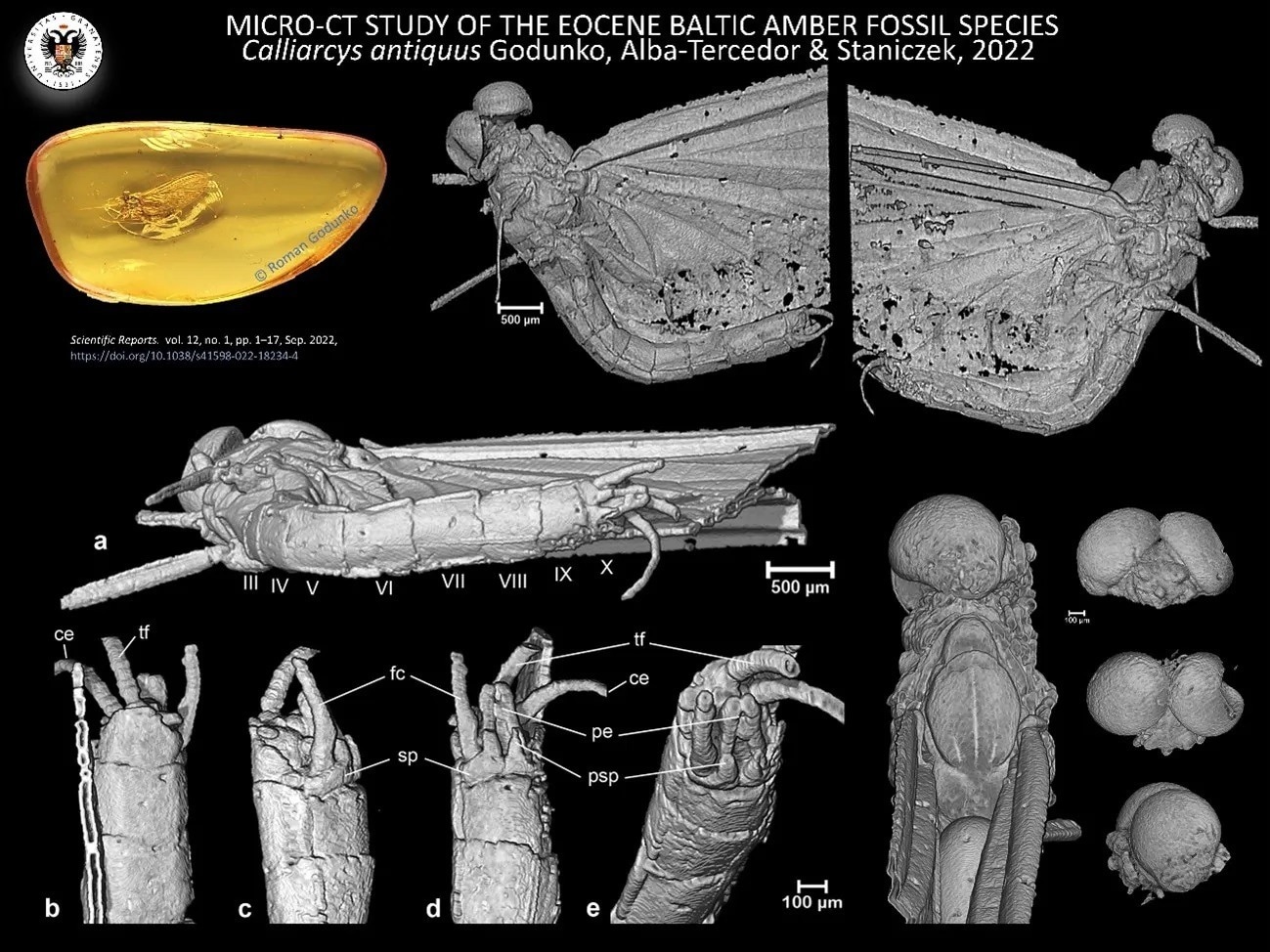Micro-computed tomography was used in a significant work by Professor Javier Alba-Tercedor of the Department of Zoology at the University of Granada to produce sharp pictures that allowed the insect to be examined and identified.
 Image of the insect. Image Credit: Canal UGR
Image of the insect. Image Credit: Canal UGR
Calliarcys antiquus, a member of the Ephemeroptera (mayfly) group, has been identified and described as a result of an international research partnership involving the University of Granada (UGR).
Arnold Staniczek of the State Museum of Natural History in Stuttgart discovered the actual specimen, which was embedded in a chunk of Baltic amber thought to be between 35 and 47 million years old.
Furthermore, the insect was able to be thoroughly examined and identified, thanks to the expertise of Professor Javier Alba-Tercedor of the UGR’s Department of Zoology, who used microtomography to produce clear photographs of the insect.
When the specimen’s cortex is damaged, plants like conifers (and some legumes) defend themselves by secreting resin, a viscous substance that is thick and sticky.
Since this resin frequently traps insects, even those that have been extinct for millions of years may still be discovered today, preserved in the hardened, fossilized resin that can be referred to as amber. Amber deposits can be found throughout the world, notably in northern Spain, but the Baltic region has the greatest concentration.
The conservation of the specimens trapped inside the amber is often excellent, and the transparency of the material that surrounds them enables them to be studied, under a microscope, in great detail. But, in other cases, the level of transparency is not good because the areas of opacity that form prevent certain details from being examined.”
Javier Alba-Tercedor, Professor, Department of Zoology, University of Granada
X-ray microtomography, a method used in hospitals to analyze patients’ organs, is beneficial in researching ancient specimens preserved in amber when this limited transparency is a concern.
This specific piece from the Baltic was entirely clear when Arnold Staniczek, a renowned specialist in Ephemeroptera with significant experience in the study of insects trapped in amber, inspected it.
The insect itself did, however, display some “hyaline” (translucent) regions surrounding specific body sections that are crucial for defining the specimen and separating one species from another, such as the end of the abdomen where the male reproductive organs (genitalia) are located.
Staniczek turned to Alba-Tercedor because of his expertise in Ephemeroptera and his extensive knowledge in the application of computerized microtomography (micro-CT) to the study of insects as this translucence made identification difficult.
Professor Alba-Tercedor rebuilt the entire insect from his base at the microtomography unit of the UGR’s Department of Zoology, including the parts that would have been impossible to see due to the amber's opacity.
The Iberian Peninsula is home to the first (officially described) species of the genus Calliarcys, which includes this particular example.
The previously undiscovered species of mayfly was subsequently studied by comparing it to living members of the genus, thanks to the skilled knowledge of Roman Godunko of the Institute of Entomology of the Czech Academy of Sciences.
In addition, the opinion of Polish specialists from the University of Łódź was also requested due to the significance of molecular studies in describing species and establishing their evolutionary position. Thus, Michal Grabowski and Tomasz Rewicz’s team concluded their investigation by analyzing the DNA of the genus’ living species.
In short, it all started with the discovery of a beautiful insect preserved in amber, which attracted the attention of the expert eyes of a scientist. And which ultimately required the enthusiastic collaboration and detective work of five scientists based in research centers located in four countries, who, after applying the latest techniques, were finally able to name and describe an insect that has remained locked inside a drop of amber for millions of years.”
Javier Alba-Tercedor, Professor, Department of Zoology, University of Granada
What is micro-CT?
Using X-rays, the micro-CT technology creates a 3D image. It employs a similar technique to computed tomography (CT), but on a smaller scale and with a lot higher resolution. While CT has resolutions measured in millimeters, micro-CT can achieve resolutions of about 0.5 micrometers.
In fact, the new nano-CTs are improving resolution even more and broadening the technological possibilities. Micro-CT is based on 3D microscopy, which makes it possible to non-invasively capture the interior structure of very small-scale objects.
With just one scan, several radiographic images can be produced to acquire high-resolution 3D-rendered images of the whole internal structure of the sample, negating the need for physical cross-sections or laborious pre-treatments. The sample is kept intact for further processing throughout the entire process.
The process entails an X-ray source “illuminating” the object and a flat X-ray detector collecting magnified projection-images of the object. The resulting X-rays from the sample are then processed using computer software into cross-sections, which are further processed through volumetric reconstruction programs to create three-dimensional images.
Source:
Journal reference:
Godunko, R. J., et al. (2022). Cenozoic origins of the genus Calliarcys (Insecta, Ephemeroptera) revealed by Micro-CT, with DNA barcode gap analysis of Leptophlebiinae and Habrophlebiinae. Scientific Reports. doi.org/10.1038/s41598-022-18234-4